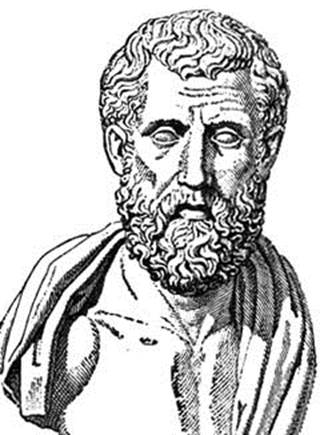


 تاريخ الرياضيات
تاريخ الرياضيات
 الرياضيات في الحضارات المختلفة
الرياضيات في الحضارات المختلفة 
 الرياضيات المتقطعة
الرياضيات المتقطعة
 الجبر
الجبر
 الهندسة
الهندسة 
 المعادلات التفاضلية و التكاملية
المعادلات التفاضلية و التكاملية 
 التحليل
التحليل
 علماء الرياضيات
علماء الرياضيات |
Read More
Date: 18-10-2015
Date: 20-10-2015
Date: 20-10-2015
|
Born: about 70 in Smyrna (now Izmir), Turkey
Died: about 135
 Little is known of Theon of Smyrna's life. He was called 'the old Theon' by Theon of Alexandria and 'Theon the mathematician' by Ptolemy. The date of his birth is little better than a guess, but we do have some firm data about dates in his life. We know that he was making astronomical observations of Mercury and Venus between 127 and 132 since Ptolemy lists four observations which Theon made in 127, 129, 130 and 132. From these observations Theon made estimates of the greatest angular distance that Mercury and Venus can reach from the Sun. The style of his bust, dedicated by his son 'Theon the priest', gives us the date of his death to within 10 years and it is placed within the period 130-140 (hence our midpoint guess of 135).
Little is known of Theon of Smyrna's life. He was called 'the old Theon' by Theon of Alexandria and 'Theon the mathematician' by Ptolemy. The date of his birth is little better than a guess, but we do have some firm data about dates in his life. We know that he was making astronomical observations of Mercury and Venus between 127 and 132 since Ptolemy lists four observations which Theon made in 127, 129, 130 and 132. From these observations Theon made estimates of the greatest angular distance that Mercury and Venus can reach from the Sun. The style of his bust, dedicated by his son 'Theon the priest', gives us the date of his death to within 10 years and it is placed within the period 130-140 (hence our midpoint guess of 135).
Theon's most important work is Expositio rerum mathematicarum ad legendum Platonem utilium. This work is a handbook for philosophy students to show how prime numbers, geometrical numbers such as squares, progressions, music and astronomy are interrelated. Its rather curious title means that it was intended as an introduction to a study of the works of Plato, but this is rather fanciful. As Huxley writes in [1]:-
... the book has little to offer the specialist student of Plato's mathematics. It is, rather, a handbook for philosophy students, written to illustrate how arithmetic, geometry, stereometry, music, and astronomy are interrelated.
The most important feature of the work is the wide range of citations of earlier sources. Its worst feature is its lack of originality. Heath writes [2]:-
Theon's work is a curious medley, valuable, not intrinsically, but for the numerous historical notices which it contains.
In the introduction Theon gives his reason for writing the work:-
Everyone would agree that he could not understand the mathematical arguments used by Plato unless he were practised in this science... One who had become skilled in all geometry and all music and astronomy would be reckoned most happy on making acquaintance with the writings of Plato, but this cannot be come by easily or readily, for it calls for a very great deal of application from youth upwards. In order that those who have failed to become practised in these studies, but aim at a knowledge of his writings, should not wholly fail in their desires, I shall make a summary and concise sketch of the mathematical theorems which are specially necessary for readers of Plato....
The work begins with a collection of theorems which Theon says will be useful for the study of arithmetic, music, geometry, and astronomy in Plato. However his coverage of geometry is none too good and later in the book he makes an excuse for this saying that anyone who reads his book, or the works of Plato, will have already studied elementary geometry.
In the section on numbers Theon adopts a Pythagorean approach, writing about odd numbers, even numbers, prime numbers, composite numbers, square numbers, oblong numbers, triangular numbers, polygonal numbers, circular numbers, spherical numbers, solid numbers with three factors, pyramidal numbers, perfect numbers, deficient numbers and abundant numbers.
The best section of Expositio rerum mathematicarum is the astronomy section which teaches that the Earth is spherical, that mountains are negligible in height compared with the Earth etc. It includes knowledge of conjunctions, eclipses, occultations and transits. However, Neugebauer writes in [3]:-
It is clear that Theon's treatise does not pretend to make original contributions to astronomy. Unfortunately it is also clear that Theon has not fully digested the material he is presenting to his readers.
Theon also wrote commentaries on the main authorities of mathematics and astronomy. In particular he wrote an important work on Ptolemy and another on Plato's Republic which he refers to himself in work which survives. Whether his work on the ancestry of Plato is a separate work or a section of one of his commentaries on Plato's work, it is impossible to say.
Books:
Articles:
3.G C Vedova, Notes on Theon of Smyrna, The American Mathematical Monthly 58 (1951), 675-683.



|
|
|
|
دراسة: حفنة من الجوز يوميا تحميك من سرطان القولون
|
|
|
|
|
|
|
تنشيط أول مفاعل ملح منصهر يستعمل الثوريوم في العالم.. سباق "الأرنب والسلحفاة"
|
|
|
|
|
|
|
الطلبة المشاركون: مسابقة فنِّ الخطابة تمثل فرصة للتنافس الإبداعي وتنمية المهارات
|
|
|